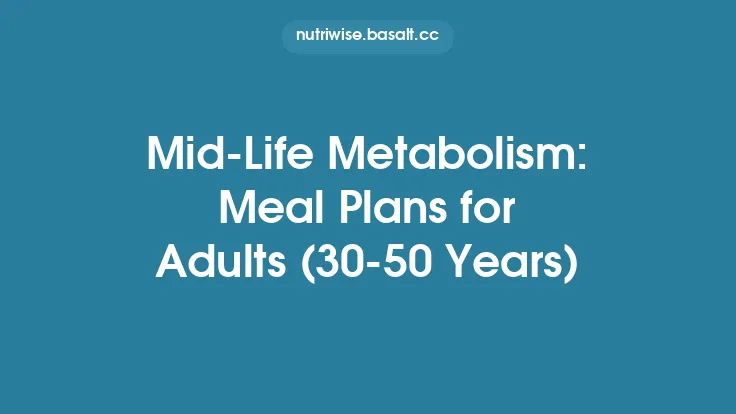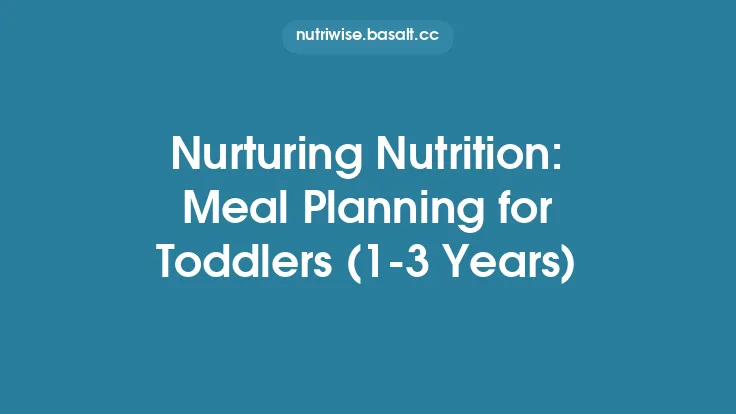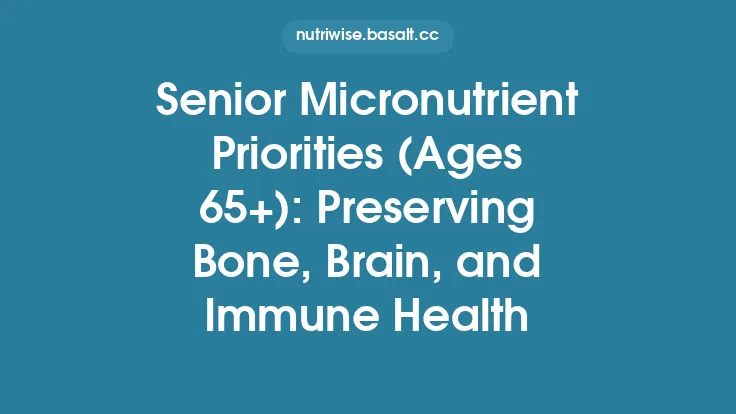Active aging is more than just staying physically fit; it’s about fueling the body with the right nutrients to support mobility, cognitive health, immune function, and overall quality of life. For adults 65 and older, the nutritional landscape shifts: caloric needs often decline while the demand for certain vitamins, minerals, and high‑quality protein rises. Crafting a nutrient‑dense meal plan that respects these changes can help seniors maintain muscle mass, bone strength, and mental sharpness, while also managing chronic conditions such as hypertension, type 2 diabetes, and cardiovascular disease.
Why Nutrient Density Matters More Than Calories
- Reduced Energy Expenditure: Metabolic rate slows with age, and many seniors are less active than they were in younger years. Consuming fewer calories while still meeting micronutrient needs prevents unwanted weight loss and malnutrition.
- Preserving Lean Body Mass: Sarcopenia—the age‑related loss of muscle—can be mitigated by prioritizing high‑quality protein (≈1.0–1.2 g/kg body weight) and essential amino acids, especially leucine.
- Bone Health: Calcium and vitamin D requirements increase to counteract bone demineralization. Vitamin K2, magnesium, and phosphorus also play supporting roles.
- Cognitive Resilience: Antioxidants (vitamins C, E, polyphenols), omega‑3 fatty acids, and B‑vitamins (especially B12, folate) have been linked to slower cognitive decline.
- Immune Support: Zinc, selenium, and vitamin A are critical for maintaining a robust immune response, which becomes less efficient with age.
Core Nutritional Pillars for Seniors
| Nutrient | Primary Functions | Recommended Daily Intake (RDI) | Food Sources |
|---|---|---|---|
| Protein | Muscle repair, immune function, satiety | 1.0–1.2 g/kg (≈60–75 g for a 70 kg adult) | Lean poultry, fish, eggs, low‑fat dairy, legumes, tofu, tempeh |
| Calcium | Bone mineralization, nerve transmission | 1,200 mg | Low‑fat dairy, fortified plant milks, leafy greens (kale, bok choy), sardines with bones |
| Vitamin D | Calcium absorption, immune modulation | 800–1,000 IU (20–25 µg) | Fatty fish, fortified dairy/plant milks, egg yolk; sunlight exposure 10–15 min daily |
| Vitamin B12 | Red blood cell formation, neurological health | 2.4 µg (higher absorption needs) | Animal products, fortified cereals, B12 supplements if needed |
| Omega‑3 (EPA/DHA) | Anti‑inflammatory, cardiovascular, brain health | 250–500 mg combined EPA/DHA | Salmon, mackerel, sardines, algae oil |
| Fiber | Digestive health, glycemic control, cholesterol reduction | 25–30 g | Whole grains, fruits, vegetables, legumes, nuts |
| Potassium | Blood pressure regulation, muscle function | 2,600–3,400 mg | Bananas, potatoes, beans, oranges, tomatoes |
| Magnesium | Bone health, glucose metabolism, nerve function | 320–420 mg | Nuts, seeds, whole grains, leafy greens |
| Antioxidants (C, E, polyphenols) | Oxidative stress reduction | Varies | Berries, citrus, nuts, seeds, dark chocolate, green tea |
Building a Balanced Plate for Seniors
- Half the Plate – Vegetables & Fruits: Aim for a colorful mix to maximize phytonutrient intake. Non‑starchy vegetables (spinach, broccoli, bell peppers) should dominate; include 1–2 servings of fruit for natural sweetness and fiber.
- One Quarter – Protein: Choose lean animal proteins or plant‑based equivalents. For those with chewing difficulties, consider soft options like scrambled eggs, Greek yogurt, or well‑cooked lentils.
- One Quarter – Whole Grains or Starchy Vegetables: Opt for high‑fiber grains (quinoa, oats, barley) or tubers (sweet potatoes) to sustain energy and support gut health.
- Healthy Fats: Incorporate a modest amount of monounsaturated and polyunsaturated fats—olive oil, avocado, nuts, seeds—to aid nutrient absorption and provide satiety.
- Hydration: Seniors often have a blunted thirst response. Aim for 1.5–2 L of fluids daily, primarily water, herbal teas, and low‑sugar beverages.
Sample One‑Week Nutrient‑Dense Meal Plan
> Note: Portion sizes should be adjusted to individual energy needs. All meals are designed to provide ~1,800–2,000 kcal per day, with ~20–25 % of calories from protein, 30 % from healthy fats, and 45–55 % from carbohydrates.
Day 1
- Breakfast: Greek yogurt (200 g) topped with fresh blueberries, a tablespoon of ground flaxseed, and a drizzle of honey; whole‑grain toast with almond butter.
- Mid‑Morning Snack: A small apple and a handful of walnuts.
- Lunch: Quinoa salad with chickpeas, diced cucumber, cherry tomatoes, feta cheese, and a lemon‑olive‑oil dressing; side of steamed broccoli.
- Afternoon Snack: Carrot sticks with hummus.
- Dinner: Baked salmon (150 g) with a herb‑citrus glaze, roasted sweet potatoes, and sautéed kale with garlic.
- Evening Snack (optional): Warm milk (low‑fat) with a pinch of cinnamon.
Day 2
- Breakfast: Oatmeal cooked in fortified soy milk, mixed with sliced banana, chia seeds, and a spoonful of peanut butter.
- Snack: Cottage cheese (½ cup) with pineapple chunks.
- Lunch: Turkey and avocado wrap on a whole‑wheat tortilla, side of mixed greens with vinaigrette.
- Snack: A small handful of dried apricots and almonds.
- Dinner: Lentil stew with carrots, celery, and spinach; served with a slice of whole‑grain bread.
- Evening Snack: A cup of herbal tea and a piece of dark chocolate (≥70 % cacao).
Day 3
- Breakfast: Scrambled eggs (2) with smoked salmon, chives, and a side of sliced tomatoes; whole‑grain English muffin.
- Snack: Pear and a few Brazil nuts (source of selenium).
- Lunch: Grilled chicken breast over a bed of mixed quinoa, roasted Brussels sprouts, and a drizzle of tahini sauce.
- Snack: Greek yogurt with a sprinkle of cinnamon.
- Dinner: Stir‑fried tofu with bell peppers, snap peas, and brown rice; seasoned with ginger, garlic, and low‑sodium soy sauce.
- Evening Snack: Warm water with a slice of lemon.
*(Continue the pattern for Days 4‑7, rotating protein sources (fish, lean beef, legumes), incorporating seasonal vegetables, and varying whole grains.)*
Practical Tips for Seniors and Caregivers
| Challenge | Solution |
|---|---|
| Reduced Appetite | Offer smaller, more frequent meals; enhance flavor with herbs, spices, and citrus; serve foods at optimal temperature. |
| Dental or Swallowing Issues | Choose soft textures (e.g., stews, pureed soups, smoothies); add protein powders or Greek yogurt to boost nutrition without extra volume. |
| Medication‑Food Interactions | Separate iron supplements from calcium‑rich foods by at least 2 hours; avoid grapefruit if on certain statins. |
| Budget Constraints | Buy frozen vegetables and fruits (nutrient retention is comparable); purchase beans and whole grains in bulk; use seasonal produce. |
| Cooking Fatigue | Batch‑cook on weekends; freeze individual portions; use slow‑cookers or pressure cookers for hands‑off preparation. |
| Memory & Organization | Keep a weekly meal calendar; label containers with dates; use simple recipes with ≤5 steps. |
Grocery List Essentials for an Active‑Aging Kitchen
- Proteins: Skinless chicken, salmon, sardines, eggs, low‑fat Greek yogurt, cottage cheese, tofu, tempeh, canned beans.
- Whole Grains: Rolled oats, quinoa, brown rice, whole‑wheat pasta, barley.
- Fruits & Vegetables: Berries, oranges, apples, bananas, leafy greens (spinach, kale), cruciferous veg (broccoli, cauliflower), sweet potatoes, carrots, bell peppers.
- Healthy Fats: Extra‑virgin olive oil, avocado, nuts (walnuts, almonds), seeds (flax, chia, pumpkin).
- Dairy/Alternatives: Low‑fat milk, fortified plant milks (almond, soy), cheese (moderate amounts).
- Flavor Boosters: Fresh herbs, garlic, ginger, lemon, low‑sodium broth, spices (cinnamon, turmeric, cumin).
- Supplements (if needed): Vitamin D3, vitamin B12, calcium‑magnesium‑vitamin D combo, omega‑3 algae oil.
Monitoring Progress and Adjusting the Plan
- Weight & Body Composition: Track weight monthly; consider bioelectrical impedance or skinfold measurements to monitor muscle vs. fat changes.
- Blood Markers: Periodic labs for vitamin D, B12, iron, lipid profile, fasting glucose, and kidney function help fine‑tune nutrient intake.
- Functional Tests: Simple assessments like the “chair stand test” or “timed up‑and‑go” provide insight into muscle strength and balance.
- Feedback Loop: Encourage seniors to note energy levels, digestion, and mood. Adjust fiber, fluid, or protein portions accordingly.
Frequently Asked Questions
Q: How much protein is safe for someone with kidney disease?
A: For mild to moderate chronic kidney disease, protein intake may be reduced to 0.6–0.8 g/kg, but it should be individualized under medical supervision. High‑quality sources (e.g., fish, eggs) are preferred.
Q: Is it necessary to take a multivitamin?
A: A well‑balanced diet can meet most needs, but vitamin D, B12, and calcium often require supplementation in seniors, especially those with limited sun exposure or dietary restrictions.
Q: Can intermittent fasting be beneficial for seniors?
A: While time‑restricted eating may improve insulin sensitivity, it should be approached cautiously. Prolonged fasting can exacerbate sarcopenia and affect medication schedules. Consultation with a healthcare professional is essential.
Q: What are the best ways to improve calcium absorption?
A: Pair calcium‑rich foods with vitamin D sources, limit excessive sodium and caffeine, and spread calcium intake throughout the day rather than consuming a large dose at once.
Closing Thoughts
Active aging thrives on the synergy between movement and nutrition. By prioritizing nutrient‑dense foods—lean proteins, colorful vegetables, whole grains, and healthy fats—seniors can preserve muscle mass, protect bone health, support cognitive function, and enjoy a vibrant, independent lifestyle. The meal plans outlined above are flexible frameworks that can be personalized to taste preferences, cultural traditions, and health conditions. Consistency, mindful eating, and regular health monitoring are the cornerstones of a successful nutrition strategy for those 65 years and older.





